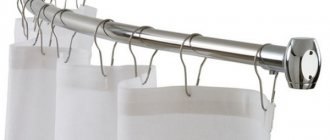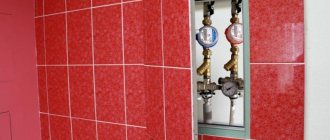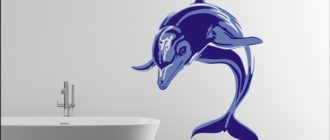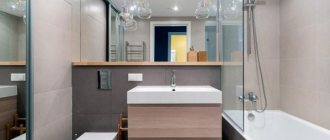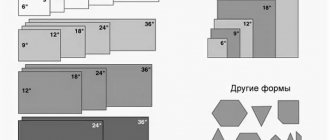A washbasin built into the countertop looks much more interesting than one standing separately, without any decoration.
And it’s more convenient to use - cosmetic accessories or a razor can be placed nearby, rather than held in your hands.
Many users will be interested in a homemade countertop in a bathroom made of tiles - this will be discussed in detail below.
Advantages and disadvantages
The following arguments speak in favor of a homemade countertop with ceramic cladding:
- affordable price . Branded granite and marble countertops, especially those made to order according to consumer sketches, are much more expensive;
- diversity. There are countless types of tiles on sale with different textures, colors, patterns and surface types. This allows the home designer to create an exclusive product that fits perfectly with the bathroom interior;
- excellent characteristics. Ceramic tiles are moisture-resistant, durable, stable to temperature changes, and are easy to keep clean. Porcelain stoneware has the best characteristics: due to the absence of pores, it is close to natural stone in terms of strength, wear resistance and water resistance.
A natural stone
A stone bathroom countertop can be described in three words – beautiful, expensive, reliable.
Note! Ideas for a combined bathroom with shower (100 photos)
Stone is a high-strength, resistant to mechanical damage and durable material. For its manufacture, matte/glossy marble or granite is often used.
The advantages include a noble appearance, good impact strength and wear resistance.
Disadvantages include high cost, heavy weight, labor-intensive installation, and subtle maintenance requirements—requires individual selection of cleaning products.
Tools and materials
To make a tabletop you will need the following arsenal:
- drill with impact mechanism;
- jigsaw;
- tile cutter for shaped cutting (you can order tile cutting in the workshop);
- levels: rack and bubble;
- roulette;
- crosshead screwdriver;
- brush;
- spatulas for laying tiles: metal (solid and serrated), rubber.
The following materials are used:
- galvanized profiles for plasterboard structures : guide and rack;
- for supports: profiled pipe or brick;
- moisture-resistant plywood (FSF);
- moisture-resistant plasterboard (GKVL) or cement-bonded particle boards;
- tiled or porcelain tiles;
- tile adhesive.
You will also need a fungicidal grout (with an antifungal additive).
Tile sizes
In ceramic cladding, the seams are a weak point, so it is advisable to use tiles that are as large as possible. But in a small room, large modules look bulky and emphasize cramped spaces.
Mosaic tiles
It is recommended to use tiles of the following sizes:
- in a spacious bathroom: from 30x30 cm to 60x60 cm or mosaic (5x5 cm or less);
- in compact: from 10x10 cm to 20x20 cm.
Frame preparation
The tabletop frame is formed as follows:
- markings are applied: on the wall 80 cm from the floor, draw a strictly horizontal line with a marker, having previously marked the extreme points using a bubble level; a rectangle is drawn on the floor, repeating the outline of the tabletop. A sign of the absence of distortions is the equality of the diagonals of the drawn figure;
- mark the position of the brick supports and remove the floor tiles in these places, having previously cut them along the contour with a grinder. The tool is equipped with a metal disk for dry cutting of stone (segmented);
- walls are erected from bricks to the level of the line drawn on the wall, fixing them with cement-sand mortar. Such supports are good because they allow you to install shelves and doors;
- The brick supports are plastered and a day later they are covered with tiles. It is important to do the finishing at this stage, since after installing the countertop it will be more difficult to implement;
- they make a frame from CD profiles for plasterboard structures. To make the frame stronger, each element is made of two profiles, inserting one into the other (they have a U-shaped section). The result is a prefabricated profile with a box-shaped section. Metal elements are fastened together with blind rivets or metal screws;
- Several cross members from the same profile are fixed in the frame to add rigidity;
- lay the frame on supports and screw one side to the wall using dowels.
In addition to stone supports, they use:
- racks made of profiled pipe with section dimensions 50x30, 40x40, 60x40 mm or purchased chrome;
- welded brackets from the corner, transferring the load from the tabletop to the wall (suspended version).
All metal parts are painted.
Benefits of drywall
Gypsum plasterboard sheets or gypsum dry plaster is a sheet material represented by two cardboard layers and a gypsum core with various fillers.
From such sheet material with a standard width of 1.2 m, you can very easily make cladding for various structures, partitions, and ceiling trim.
The following main dimensional standards are distinguished:
- 300×120 cm;
- 250×120 cm;
- 200×120 cm.
The thickness of the ceiling plasterboard sheets is 9.5 mm, the wall thickness is 1.25 cm, and the arched sheet is 0.65 cm.
The plasterboard structure can be simple or multi-level, convenient for placing household appliances and plumbing fixtures.
Advantages of the material
The undeniable advantages of plasterboard sheets of any type are presented:
- excellent thermal insulation characteristics;
- optimal flexibility and ease of use, which allows you to create not only traditional rectangular cascades, but also semicircular arched structures;
- quite decent fire resistance;
- ease of hiding communication and cable systems.
Finished countertop
The space created behind the installed panels allows for trouble-free placement of wires and pipes.
The absence of special inspection hatches will require the dismantling of panels in order to carry out repair and maintenance work on hidden communications.
Disadvantages of the material
Plasterboard sheets have some noticeable disadvantages, presented by:
- insufficient strength indicators, which may be accompanied by the appearance of cracks in the material during transportation, installation and operation;
- low soundproofing characteristics;
- inability to support significant weight loads.
Drywall sheets
To make the plasterboard structure as strong and reliable as possible, it is recommended to use two-layer systems with special butterfly dowels.
The design and shape of the structure in the bathroom must be thought out in advance, taking into account the frame base and the location of niches for accessories.
Sheathing
The base of the tabletop is attached to the frame, manufactured as follows:
- From a sheet of moisture-resistant plywood of the FSF brand with a thickness of 19 mm, cut out two identical blanks and glue them together, laying them on top of each other. If the design of the tabletop involves curved outlines, cutting is done with a jigsaw;
- lay the plywood base on the frame and screw it to it with metal screws;
- glue onto the top and ends of the plywood a material similar in thermal expansion coefficient to ceramic tiles. For plywood, this indicator is very different, so you cannot glue tiles directly onto it.
The following materials are used:
- cement particle board (CSB) with a thickness of 6 – 13 mm;
- moisture-resistant plasterboard sheet (GKLV).
When cutting with a grinder, the DSP generates a lot of dust. It is more correct to make cuts with a construction knife and then break the slab on the corner of the table. If necessary, the ends are ground. The DSP is screwed to the plywood with self-tapping screws, having previously countersunk the holes so that the caps are flush.
The following manipulations are performed with the gypsum board sheet:
- glue it to the plywood with tile adhesive and additionally fix it with self-tapping screws;
- apply two layers of nitro varnish diluted with nitro solvent on top and on the ends;
- fill the joints with silicone sealant “For aquarium” (excess is immediately removed);
- seal the joints with sickle tape;
- apply 2-component automotive putty (the cheapest one will do) with a thickness of 1-2 mm on top and on the ends with a medium-width spatula;
- After waiting for the putty to harden (it takes about an hour), sand it with coarse sandpaper, wrapping it around the block.
Next, an opening for the sink is cut out at the base using a jigsaw. In the case of using gypsum plasterboard, this is done before applying a protective coating of nitro varnish. Modern sinks are equipped with a template - the opening is cut out from it.
In the absence of a template, you will have to make it yourself. To thread the jigsaw blade, drill a small hole on the contour of the opening with a drill.
Due to the high drying speed, automotive putty should be prepared in small portions.
Glass
Glass models, the newest, most unusual to date. They look modern, weightless, and add a special style to the room.
They are made from thick, dense glass, so they weigh a lot. Most often they can be seen complete with sinks, since they are not cut independently, and manufacturers immediately make the set.
- Bathroom cabinet - 110 photos of beautiful examples of 2019-2020 using a cabinet in the bathroom
Bathroom accessories - the most necessary popular and beautiful decorative elements (75 photos)
Bathroom cabinet - decor and small tricks when designing a bathroom (85 photos)
Some types of countertops can be made independently, but this cannot be done with all types of material. A do-it-yourself tabletop, made skillfully and in compliance with all the rules, will look no worse than the rest.
There is a huge selection of countertops for the bathroom; it is not easy to choose the right model; you have to be guided by the price and quality of the product. For a wet room, it is important to choose not only a beautiful tabletop, but first of all it must be practical.
Below are photos of a bathroom countertop, where you can clearly see all the varieties and choose the most applicable option for yourself.
Tiling
Tiles for countertops are selected according to the following criteria:
- type . The surface of the countertop is not subject to significant loads, so wall tiles are sufficient (there is an icon with a hand on the package);
- surface . Relief tiles look interesting, but they are difficult to keep clean: dirt is firmly held in uneven areas;
- color . All shades of blue, reminiscent of the sea, are always appropriate in the bathroom: azure, turquoise, sea green. You can add white or make the tabletop red and black.
Tiling is done as follows:
- treat the surface of the base of the tabletop with a latex-based primer - it will increase the adhesive strength of the glue. Work continues after the primer has dried, which takes a day;
- The glue is applied with a spatula with a straight blade. For leveling, notched spatulas are used, which have different tooth heights; this determines the thickness of the adhesive layer. Typically, tile adhesive manufacturers indicate on the packaging which spatula to use to apply the mixture when gluing tiles of different sizes;
- lay the tiles on the layer of glue, using a slatted level to mark the horizontal position. The method of gluing the mosaic depends on the type of flexible base: the synthetic mesh should be on the bottom, the paper mesh on top. After the glue has hardened, the paper is soaked and removed;
- Apply glue again and glue the next module, inserting plastic crosses into the seam between it and the previous one. Cross stitches ensure that all seams are of equal width. When gluing mosaics, select crosses with a width equal to the width of the seams between the chips. The glue that comes out of the seams is wiped off with a rag;
- continue to glue the tiles, leveling the modules relative to each other;
- The tiles adjacent to the sink are cut using a tile cutter for curved cutting. Tiles for gluing the ends can be cut with a regular tile cutter, a diamond glass cutter (if the thickness is small) or a grinder.
The ends can be decorated using a special part - an outer corner. The glue used is waterproof. Better - cement glue diluted instead of water on latex.
It is not advisable to use expensive and difficult-to-work epoxy adhesive, which is characterized by the highest water resistance, in this case, since the countertop is not constantly exposed to direct water.
If the product is going to be covered with glass mosaic, white glue is required.
Tree
A wooden bathroom countertop is recognized as the most environmentally friendly and expensive. It is believed that wood should not be in a damp room, so manufacturers urge that such countertops be properly cared for and wiped with antiseptic agents more often.
In turn, during production they are coated with a special varnish. Experts advise choosing wooden countertops made from hardwood.
Grouting joints
The grout is also moisture resistant. Cement-based latex is also preferable; there is no point in buying expensive epoxy. An exception is if silver or gold powder is supposed to be added to the epoxy grout, as is done in expensive interiors.
Filling of joints begins a day after gluing the tiles:
- Remove glue residue from the seams using a special scraper coated with tungsten or diamond. In its absence, a construction knife is used;
- moisten the seams with a spray bottle or a damp sponge;
- Apply the grout to a rubber spatula and rub it into the seams, trying to fill them as much as possible. It is useful to press the mixture with the blade of a spatula and then go over the seam again, filling the resulting void;
- in 15 – 20 minutes. After starting work, return to the first area and wipe off traces of grout from the tiles with a rag or damp sponge. This moment is the most suitable, since the mixture has not yet dried and can be removed, but at the same time it has already hardened somewhat and therefore is not squeezed out of the seam with careless movement.
Contact of grout with water is allowed no earlier than after two days.
You should add an antifungal additive to the grout or buy a ready-made fungicidal composition.

